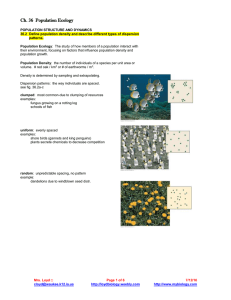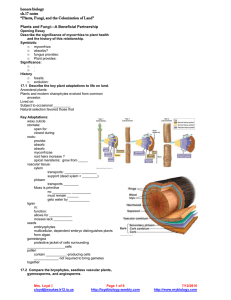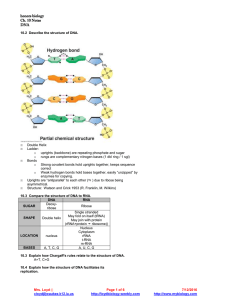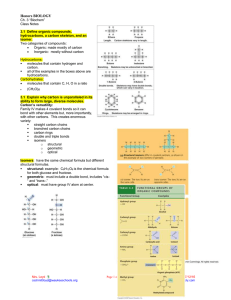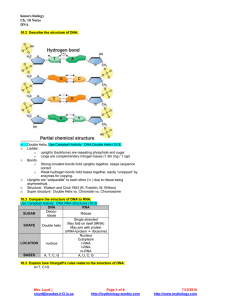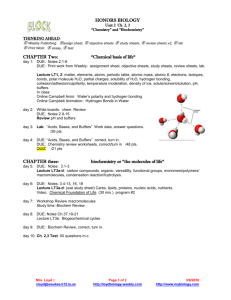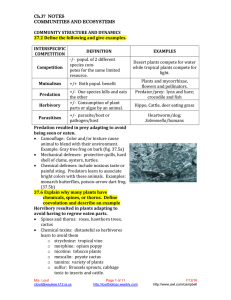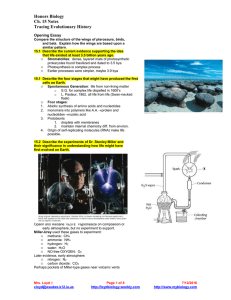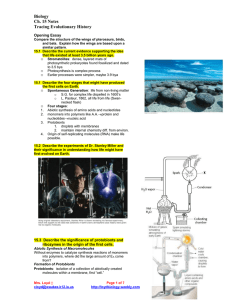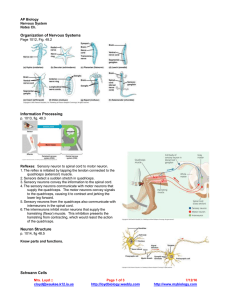Honors BIOLOGY
advertisement
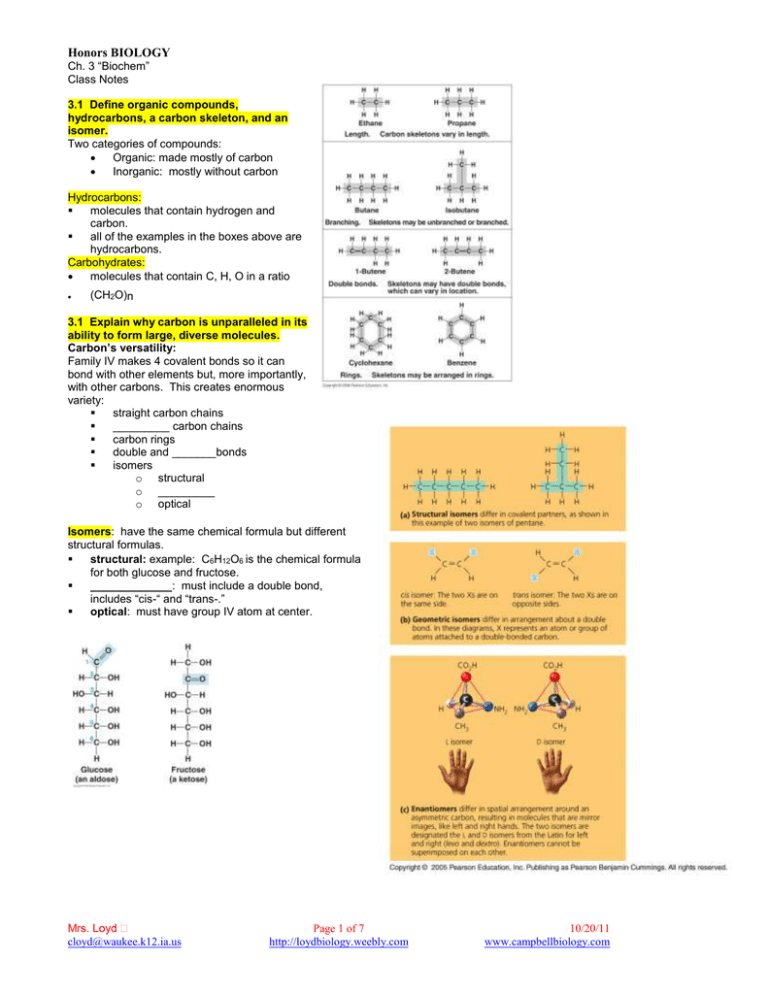
Honors BIOLOGY Ch. 3 “Biochem” Class Notes 3.1 Define organic compounds, hydrocarbons, a carbon skeleton, and an isomer. Two categories of compounds: Organic: made mostly of carbon Inorganic: mostly without carbon Hydrocarbons: molecules that contain hydrogen and carbon. all of the examples in the boxes above are hydrocarbons. Carbohydrates: molecules that contain C, H, O in a ratio (CH2O)n 3.1 Explain why carbon is unparalleled in its ability to form large, diverse molecules. Carbon’s versatility: Family IV makes 4 covalent bonds so it can bond with other elements but, more importantly, with other carbons. This creates enormous variety: straight carbon chains _________ carbon chains carbon rings double and _______bonds isomers o structural o _________ o optical Isomers: have the same chemical formula but different structural formulas. structural: example: C6H12O6 is the chemical formula for both glucose and fructose. _____________: must include a double bond, includes “cis-“ and “trans-.” optical: must have group IV atom at center. Mrs. Loyd cloyd@waukee.k12.ia.us Page 1 of 7 http://loydbiology.weebly.com 10/20/11 www.campbellbiology.com 3.2 Describe the properties of and distinguish between the six chemical groups important in the chemistry of life. table 3.2 DO NOT MEMORIZE THIS TABLE! Be able to recognize the groups. Know that they have “personalities that they lend to the carbon skeleton to which they are bound. Functional Groups: Chemical groups that affect a molecule’s function by participating in chemical reactions in characteristic ways. Polar (except methyl) same as water molecule hydrophilic “water loving” “Like dissolves like.” Polar dissolves polar. Nonpolar dissolves nonpolar. Polar and Nonpolar don’t mix. Water and oil. Cells are mostly water Functional groups must be able to dissolve in water. Quiz yourself: 1. Is water polar or nonpolar? 2. If a substance is repelled by water (hydrophobic or “water fearing,” is it polar or nonpolar? 3.3 Compare the processes of dehydration synthesis and hydrolysis. Building Macromolecules: monomers polymers (anabolic process): Dehydration Synthesis or condensation reactions. H+ and OH- are removed to create bonding sites. This makes water Breaking Down Macromolecules: polymers monomers (catabolic process): Hydrolysis Draw the picture representing Hydrolysis based on the diagram for dehydration synthesis given above. Mrs. Loyd cloyd@waukee.k12.ia.us Page 2 of 7 http://loydbiology.weebly.com 10/20/11 www.campbellbiology.com Ch. 3.3 Molecules of Life: Macromolecules List the four main classes of macromolecules and explain the relationship between monomers and polymers. Carbohydrates: carbon, hydrogen, and oxygen. Monomer = monosaccharide (simple sugar) (CH2O)n where n = 3 8. A six-carbon monosaccharide would be C6H12O6. Monosaccharides: common examples: glucose: main source of energy in cells fructose: fruit sugar and the sweetest _ _ _ _ _ _ ose: milk Because all of the simple sugars (say, 6C sugars) have the same chemical formula but different structural formulas (built differently) they have slightly different chemical properties and are called isomers. Disaccharides: _ _ _ _ _ _ sugar two monosaccharides example: sucrose Polysaccharides: several to hundreds of simple sugars put together. glycogen: animal sugar storage (shortterm) in liver and muscles for quick use. _ _ _ _ _ _ : plant sugar storage cellulose: plant support _ _ _ _ _ _ : exoskeleton Lipids: _ _ _ glycerides Nonpolar therefore they (do / do not) mix with water. Hydrophobic Monomers for triglyceride: glycerol + fatty acids Mrs. Loyd cloyd@waukee.k12.ia.us Page 3 of 7 http://loydbiology.weebly.com 10/20/11 www.campbellbiology.com Saturated Fats: solid carbons are saturated with hydrogen All C-C bonds are single single bonds allow F.A. tails to pack neatly animal fat is (solid/ liquid) at room temperature cause plaques in blood vessels (atherosclerosis) Unsaturated Fats: oil some carbons have double _ _ _ _ _ forcing hydrogen into it (_ _ _ _ _ genation) kinks in F.A. tails (does / doesn’t) allow for easy packing liquid at _ _ _ _ temperature---oils Crisco = partially hydrogenated vegetable oil Hydrogenation caused some double bonds to become single bonds allowing the oil to be solid at room temp. Original process caused some double bonds to convert from cis- bonds to _ _ _ _ _ -fat bonds. _ _ _ _ _ -fat bonds are not metabolized---cause ________ ________ . see supplemental information on Weebly for more info. Reminder Lipids: Phospholipids o o Contains both hydrophilic (head) and hydrophobic parts (tails). “Like dissolves _ _ _ _ .” Heads with water, tails with _ _ _ _ _ . Creates a phospholipid bilayer present in ALL membranes. Mrs. Loyd cloyd@waukee.k12.ia.us Page 4 of 7 http://loydbiology.weebly.com 10/20/11 www.campbellbiology.com Lipids: _ _ _ _ _ _ _ _ and cholesterol Structure of cholesterol Waxes: see supplemental information on Weebly for more info. Proteins: carbon, hydrogen, oxygen, and n _ _ _ _ _ _ _ Monomer = amino acids ( _ _ different) works like our alphabet to create variation. Each A.A. has an _ _ _ _ _ group and a _ _ _ _ _ _ _ _ group. They differ in their side chains “R”. dipeptides and polypeptides are created by condensation reactions. The resulting bond is a _ _ _ _ _ _ _ bond. Primary Structure of Protein: Determined by the kind, sequence and number of amino acids in a chain. 3.14, 3.15 Secondary, Tertiary, and sometimes Quaternary Structure: This chain folds on itself due to the interaction of the different amino acid side chains (R groups) and the backbone too. Sometimes, more than one polypeptide must combine to create a finished protein. (ex] collagen and hemoglobin) Mrs. Loyd cloyd@waukee.k12.ia.us Page 5 of 7 http://loydbiology.weebly.com 10/20/11 www.campbellbiology.com Functions of Proteins: very diverse enzymatic: ex] sucrase (digests sucrose) cell membrane: ex] transmembrane protein messenger molecules: ex] insulin immunity: ex] antibodies structural: ex] muscles, hair, fingernails, hooves, talons, horns A SPECIAL CASE OF PROTEINS Enzymes: are biological catalysts protein __________-fit model (fig 3-9; p.57) substrate active site optimal conditions: _ _ _ _./pH lose shape/lose function Nucleic Acids: DNA, __ __ __, ATP Monomer: nucleotides (phosphate, sugar, base) DNA: deoxyribonucleic acid heredity: material physically passed to next generation control: genes (DNA) code for protein (enzymes) Monomer: nucleotide RNA: ribonucleic acid messenger (_ __ __ __) transport (tRNA) organization (rRNA). How are the two types of nucleic acids functionally related? The hereditary material of DNA contains the instructions for the primary structure of polypeptides (like enzymes). RNA is the intermediary that ____________those instructions into the order of__________ ________. Mrs. Loyd cloyd@waukee.k12.ia.us Page 6 of 7 http://loydbiology.weebly.com 10/20/11 www.campbellbiology.com Simplified diagram, know this one. Consider the importance of the nitrogen bases especially adenine: DNA: the code for proteins RNA: carries the code to make proteins into the cytoplasm ATP: energy molecule of the cell All of these contain the double-ringed nitrogen base: adenine. Is it just a coincidence that caffeine and chocolate have VERY similar structures to other ESSENTIAL molecules of life? Caffeine Mrs. Loyd cloyd@waukee.k12.ia.us Chocolate Page 7 of 7 http://loydbiology.weebly.com 10/20/11 www.campbellbiology.com
